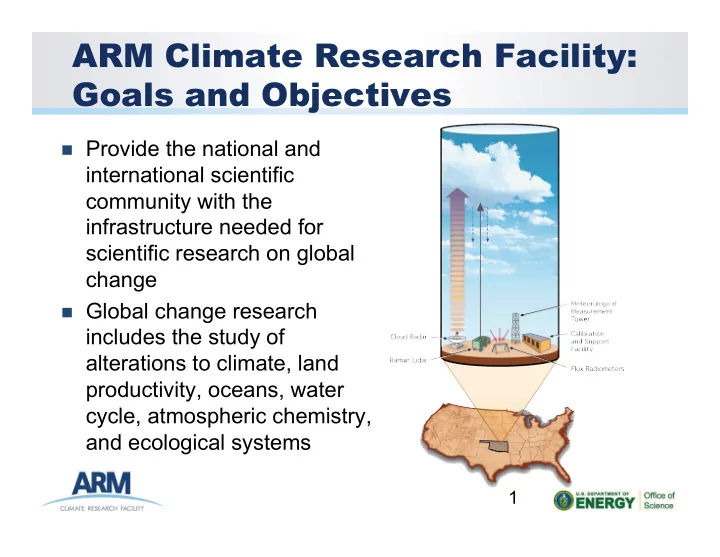

ARM Climate Research Facility: Goals and Objectives Provide the national and international scientific community with the infrastructure needed for scientific research on global change Global change research includes the study of alterations to climate, land productivity, oceans, water cycle, atmospheric chemistry, and ecological systems 1
Accomplishing the Mission Maintain and augment the collection of comprehensive and continuous long-term data sets that provide measurements of radiation, aerosols, clouds, precipitation, dynamics, and thermodynamics over a range of environmental conditions at several fixed and mobile sites situated in climatically diverse locations. Supplement the long-term data sets with laboratory studies and shorter-duration field campaigns, both ground-based and airborne, to target specific atmospheric processes under a diversity of locations and atmospheric conditions. 2
Accomplishing the Mission (cont.) Use these data, together with models, to understand and parameterize the processes that govern the atmospheric components and their interactions over all pertinent scales. Develop integrated, scale-bridging testbeds for model parameterizations that incorporate this process-level understanding of the life cycles of aerosols, clouds, and precipitation in numerical models. 3
Resolving the Most Critical Uncertainties of Climate Change The three high-priority science questions that summarize this critically needed research are: 1. What are the present deficiencies in cloud formulations and cloud feedback representations in climate models, and how can they be eliminated? 2. What are the climatically relevant chemical and physical properties of aerosols that control their effects on the atmosphere's radiation balance, and how can they be best represented in climate models? 3. What are the present deficiencies in terrestrial carbon cycle feedback representations in climate models, and how can they be eliminated? 4
Facility Components Research sites – permanent, mobile, and aerial Instruments and measurements Data processing, data quality, Data Archive Field campaigns – ground-based and airborne 5
ARM Research Sites Southern Great Plains (1993) North Slope of Alaska: Barrow (1998) and Atqasuk (1999) Tropical Western Pacific: Manus (1996), Nauru (1998), and Darwin (2002) First ARM Mobile Facility (2005); Second ARM Mobile Facility (2010) ARM Aerial Facility (2007) 6
Categories of Measurements and Instruments Cloud profiles: millimeter radar and lidar Temperature/relative humidity/wind profiles: radiosondes Column water: microwave radiometer Column aerosol: solar spectral radiometer In situ aerosol optical and cloud nucleation properties Surface radiation budget: solar and terrestrial IR radiometers Surface meteorology: T/RH/wind Additional instruments being deployed through the Recovery Act 7
Data Products Most instrument data are processed to a standard NetCDF format before being delivered to the Archive. 2 ¡T ¡Bytes ¡ When necessary, higher- order Value-Added Products (VAPs) are developed. VAPs serve a variety of purposes including: Merging data from multiple instruments Providing derived parameters Adding QC/QA information 8
Recovery Act: Introduction $60M from DOE Office of Science for investments in instrumentation and research infrastructure to support the instrumentation and the associated increase in data volume and complexity 3-dimensional measurements of cloud scale dynamics, microphysics, and precipitation Enhanced measurements of atmospheric aerosol composition and chemistry Enhance measurement base to bridge new knowledge into, and improve, the predictive performance of climate models http://www.arm.gov/about/recovery-act 9
SGP Original Configuration 1992 10
SGP Reconfiguration 2011 11
ARM Designated a DOE National Scientific User Facility in 2004 The Southern Great Plains ARM Site locale was chosen to take advantage of existing networks: the NOAA wind profiler demonstration network, the Oklahoma (and Kansas) mesonet, and others. Other networks have placed instruments/sites at ARM sites (BSRN, USDA UV-B, MPLnet, etc.): synergism not duplication. http://www.arm.gov 12
Recommend
More recommend